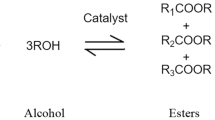Abstract
This paper reports the results of an experimental investigation of graphene particle suspensions in lubricating oil, ethylene glycol and glycerol-based fluids. Graphene particles of different specific surface area show variation in the viscosity depending on the shear rate and the temperature. The lubricating effect, e.g., reduction in the viscosity compared to the base fluid, is observed for the concentration (below 0.4 mass%) in lubricating oil and glycerol. In the range of parameters studied (e.g., concentration below 1 mass% and temperature up to 80 °C), the activation energy slightly decreases. The enhancement of viscosity with graphene volume fraction is larger for ethylene glycol.
Graphical abstract














Similar content being viewed by others
References
Ahammed N, Asirvatham LG, Wongwises S. Effect of volume concentration and temperature on viscosity and surface tension of graphene-water nanofluid for heat transfer applications. J Therm Anal Calorim. 2016;123(2):1399–409. https://doi.org/10.1007/s10973-015-5034-x.
Arshad A, Jabbal M, Yan Y, et al. A review on graphene based nanofluids: preparation, characterization and applications. J Mol Liq. 2019;279:444–84. https://doi.org/10.1016/j.molliq.2019.01.153.
Bakak A, Lotfi M, Heyd R, et al. Viscosity and rheological properties of graphene nanopowders nanofluids. Entropy. 2021;23(8):979. https://doi.org/10.3390/e23080979.
Bortolato M, Dugaria S, Agresti F, et al. Investigation of a single wall carbon nanohorn-based nanofluid in a full-scale direct absorption parabolic trough solar collector. Energy Convers Manag. 2017;150:693–703. https://doi.org/10.1016/j.enconman.2017.08.044.
Cabaleiro D, Colla L, Barison S, et al. Heat transfer capability of (ethylene glycol+water)-based nanofluids containing graphene nanoplatelets: design and thermophysical profile. Nanoscale Res Lett. 2017;12(1):1–11. https://doi.org/10.1186/s11671-016-1806-x.
Cong P, Xu P, Chen S. Effects of carbon black on the anti-aging, rheological and conductive properties of sbs/asphalt/carbon black composites. Constr Build Mater. 2014;52:306–13. https://doi.org/10.1016/j.conbuildmat.2013.11.061.
Fakhari A, Fernandes C, Galindo-Rosales FJ. Mapping the volume transfer of graphene-based inks with the gravure printing process: influence of rheology and printing parameters. Materials. 2022;15(7):2580. https://doi.org/10.3390/ma15072580.
Guazzelli E, Morris JF. A physical introduction to suspension dynamics. Cambridge: Cambridge University Press; 2011. https://doi.org/10.1017/CBO9780511894671.001.
Halelfadl S, Estellé P, Aladag B, et al. Viscosity of carbon nanotubes water-based nanofluids: influence of concentration and temperature. Int J Therm Sci. 2013;71:111–7. https://doi.org/10.1016/j.ijthermalsci.2013.04.013.
Hamze S, Cabaleiro D, Estellé P. Graphene-based nanofluids: a comprehensive review about rheological behavior and dynamic viscosity. J Mol Liq. 2021;325(115):207. https://doi.org/10.1016/j.molliq.2020.115207.
Iranmanesh S, Mehrali M, Sadeghinezhad E, et al. Evaluation of viscosity and thermal conductivity of graphene nanoplatelets nanofluids through a combined experimental-statistical approach using respond surface methodology method. Int Commun Heat Mass Transf. 2016;79:74–80. https://doi.org/10.1016/j.icheatmasstransfer.2016.10.004.
Kole M, Dey TK. Investigation of thermal conductivity, viscosity, and electrical conductivity of graphene based nanofluids. J Appl Phys. 2013;113(8): 084307. https://doi.org/10.1063/1.4793581.
Larsen T, Søbye AL, Royer JR, et al. Rheology of polydisperse nonspherical graphite particles suspended in mineral oil. J Rheol. 2022;67(1):81–9. https://doi.org/10.1122/8.0000511.
Lee GJ, Rhee CK. Enhanced thermal conductivity of nanofluids containing graphene nanoplatelets prepared by ultrasound irradiation. J Mater Sci. 2014;49(4):1506–11. https://doi.org/10.1007/s10853-013-7831-6.
Lotfi M, Heyd R, Bakak A, et al. Experimental measurements on the thermal conductivity of glycerol-based nanofluids with different thermal contrasts. J Nanomater. 2021. https://doi.org/10.1155/2021/3190877.
Mehrali M, Sadeghinezhad E, Latibari ST, et al. Investigation of thermal conductivity and rheological properties of nanofluids containing graphene nanoplatelets. Nanoscale Res Lett. 2014;9(1):1–12. https://doi.org/10.1186/1556-276X-9-15.
Moghaddam MB, Goharshadi EK, Entezari MH, et al. Preparation, characterization, and rheological properties of graphene-glycerol nanofluids. Chem Eng J. 2013;231:365–72. https://doi.org/10.1016/j.cej.2013.07.006.
Novoselov KS, Geim AK, Morozov SV, et al. Electric field effect in atomically thin carbon films. Science. 2004;306(5696):666–9. https://doi.org/10.1126/science.1102896.
Pavía M, Alajami K, Estellé P, et al. A critical review on thermal conductivity enhancement of graphene-based nanofluids. Adv Coll Interface Sci. 2021;294(102):452. https://doi.org/10.1016/j.cis.2021.102452.
Peixinho J, Karanjkar PU, Lee JW, et al. Rheology of hydrate forming emulsions. Langmuir. 2010;26(14):11699–704. https://doi.org/10.1021/la101141j.
Ruthven DM. Principles of adsorption and adsorption processes. Hoboken: Wiley; 1984.
Sadeghinezhad E, Mehrali M, Saidur R, et al. A comprehensive review on graphene nanofluids: recent research, development and applications. Energy Convers Manag. 2016;111:466–87. https://doi.org/10.1016/j.enconman.2016.01.004.
Sandeep N. Effect of aligned magnetic field on liquid thin film flow of magnetic-nanofluids embedded with graphene nanoparticles. Adv Powder Technol. 2017;28(3):865–75. https://doi.org/10.1016/j.apt.2016.12.012.
Segur JB, Oberstar HE. Viscosity of glycerol and its aqueous solutions. Ind Eng Chem. 1951;43(9):2117–20. https://doi.org/10.1021/ie50501a040.
Soares YCF, Cargnin E, Naccache MF, et al. Influence of oxidation degree of graphene oxide on the shear rheology of poly (ethylene glycol) suspensions. Fluids. 2020;5(2):41. https://doi.org/10.3390/fluids5020041.
Takamura K, Fischer H, Morrow NR. Physical properties of aqueous glycerol solutions. J Petrol Sci Eng. 2012;98:50–60. https://doi.org/10.1016/j.petrol.2012.09.003.
Vakili M, Khosrojerdi S, Aghajannezhad P, et al. A hybrid artificial neural network-genetic algorithm modeling approach for viscosity estimation of graphene nanoplatelets nanofluid using experimental data. Int Commun Heat Mass Transf. 2017;82:40–8. https://doi.org/10.1016/j.icheatmasstransfer.2017.02.003.
Vallejo JP, Żyła G, Fernández-Seara J, et al. Influence of six carbon-based nanomaterials on the rheological properties of nanofluids. Nanomaterials. 2019;9(2):146. https://doi.org/10.3390/nano9020146.
Wang Y, Al-Saaidi HAI, Kong M, et al. Thermophysical performance of graphene based aqueous nanofluids. Int J Heat Mass Transf. 2018;119:408–17. https://doi.org/10.1016/j.ijheatmasstransfer.2017.11.019.
Acknowledgements
The authors thank Prof. Philippe Barboux for the BET measurements.
Funding
The authors declare that no funds, grants or other support were received during the preparation of this manuscript.
Author information
Authors and Affiliations
Contributions
JB, RH, GR, AA and JP contributed to the conception and design of the study. JB and JP acquired the data. JB, RH and JP analyzed or interpreted the data. JB and JP drafted the manuscript. RH, GR, AA and JP revised the manuscript. All authors have read and agreed to the published version of the manuscript
Corresponding author
Ethics declarations
Conflict of interest
On behalf of all authors, the corresponding author states that there is no conflict of interest. The authors have no relevant financial or non-financial interests to disclose.
Additional information
Publisher's Note
Springer Nature remains neutral with regard to jurisdictional claims in published maps and institutional affiliations.
Rights and permissions
Springer Nature or its licensor (e.g. a society or other partner) holds exclusive rights to this article under a publishing agreement with the author(s) or other rightsholder(s); author self-archiving of the accepted manuscript version of this article is solely governed by the terms of such publishing agreement and applicable law.
About this article
Cite this article
Bao, J., Heyd, R., Régnier, G. et al. Viscosity of graphene in lubricating oil, ethylene glycol and glycerol. J Therm Anal Calorim 148, 11455–11465 (2023). https://doi.org/10.1007/s10973-023-12498-2
Received:
Accepted:
Published:
Issue Date:
DOI: https://doi.org/10.1007/s10973-023-12498-2




